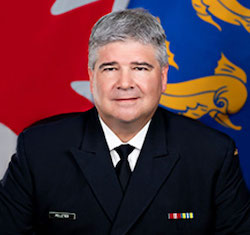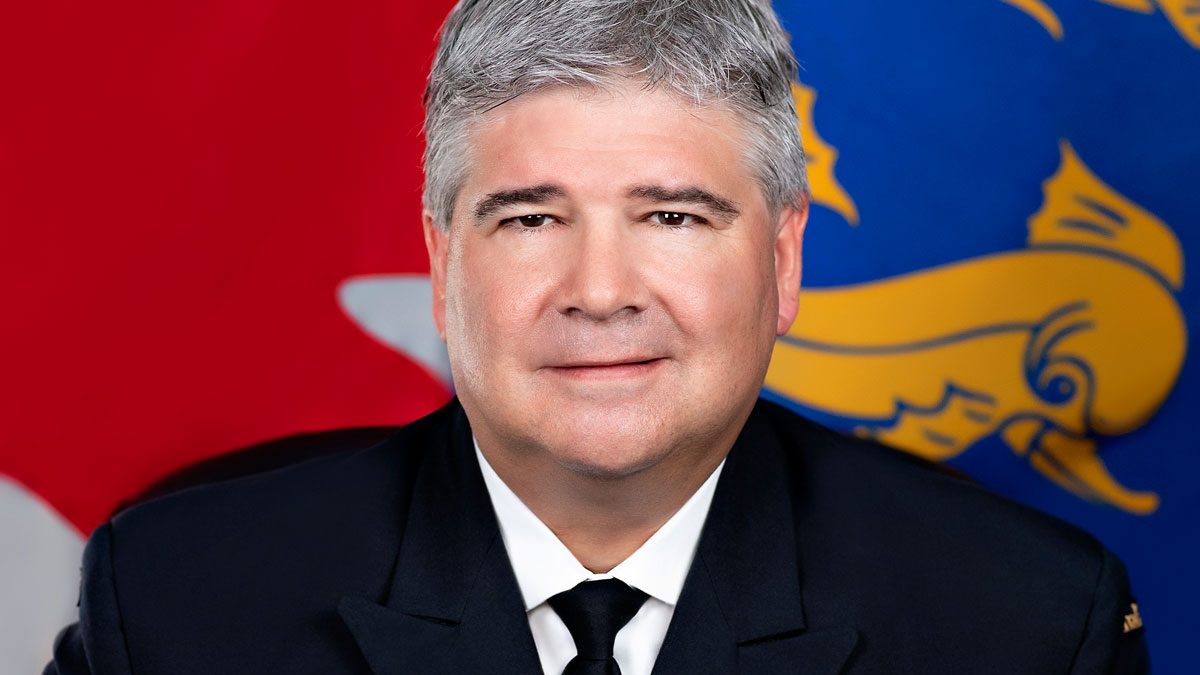Recently, Vanguard had the opportunity to interview Mario Pelletier, Commissioner of the Canadian Coast Guard (CCG). This interview was first published in the February/March 2020 issue.

Mr. Pelletier began working for the CCG in 1989 as an engineer officer in the Quebec Region. In 1998, he joined headquarters, where he held positions with increasing responsibilities. In 2011, he was appointed Director General, Fleet, a position which he held until the new organizational structure of the CCG took effect on October 1, 2012, when he became the Assistant Commissioner, Central and Arctic Region.
On June 1, 2015, he was appointed the Deputy Commissioner of Operations and received a Commissioner’s Commendation in recognition of his strong leadership, commitment and high level of expertise and professionalism. He was appointed Commissioner of the CCG on December 9, 2019. He brings to his new role a vast experience and well-established reputation for meeting challenges and obtaining desired results.
Mr. Pelletier, congratulations on your recent appointment as Commissioner of the CCG! To begin, tell us a little about your new role and some of the initiatives you are currently responsible for?
The role of Commissioner is one I take on with great pride, having spent my entire career with Coast Guard going all the way back to 1985 when I started at the Canadian Coast Guard College in Sydney, Nova Scotia.
The Canadian Coast Guard is undergoing one of the greatest periods of change in our history. We are working with our new Minister, Bernadette Jordan, to implement her priorities for the Government of Canada, and the Coast Guard is at the heart of many key priorities, including the renewal of our fleet, the building of a blue economy strategy and the Ocean Protection Plan.
I am also committed to the employees and future employees of this organization. Last fall, we announced a new structure for the Coast Guard Headquarters (HQ) in Ottawa that is meant to strengthen and modernize our organization. My focus is on implementing this new structure to support our people across the country so that they are best placed with tools and resources to achieve Coast Guard’s objectives.
Having said this, “Safety First, Service Always” is the Canadian Coast Guard motto and the guiding principle in everything we do. The safety and security of our people and the people we serve will always be my top priority.
How do you see the Coast Guard evolving, specifically since the CCG is a regional organization, do you see a more centralized control of the fleet?
The Coast Guard is a regional organization with a unified national approach providing functional leadership centered in its HQ in Ottawa. The national team provides support to the Coast Guard Fleet, programs and the assets used by shore and seagoing personnel by providing national vision, program policy, engineering support, operational and technical standards and plans. These include, but are not limited to, ships and small vessels, helicopters and operational bases, centres and stations. HQ oversees the operational requirements of the Fleet, ensures the adequacy of readiness and planning, assists in fleet navigation and communication, and provides expertise for marine communications and traffic services, aids to navigation, waterways, as well as Coast Guard icebreaking operations while the actual operations are delivered in the region.
We also have the Canadian Coast Guard College, a national maritime training facility located in Cape Breton Island, Nova Scotia. It’s a national college that provides training and services, and delivers programs to support the College’s mission and mandate in marine safety, security and environmental protection.
To follow on from above, recent internal changes have the Integrated Technical Services (ITS) directorate shifting from DC Operations to the former DC Strategy and Shipbuilding – coupled with a complete CCG fleet regeneration of large ships, and based on common platform design and manufacture. How do you see Integrated Logistics Support (ILS) to the fleet evolving, and do you envision going to a class-based In-Service Support (ISS) contract for through-life support, as the Royal Canadian Navy (RCN) has done?
The Coast Guard implements a national vessel asset class management approach for the various classes of vessels in our fleet (and other shore-based assets such as aids to navigation, etc.). In addition, the Coast Guard implements a national life cycle management approach to maintain, monitor and evaluate the performance of various vessel fitted equipment and systems as well as all other assets.
Maintenance and repair activities for Coast Guard vessels are supported by the ship’s crew, Marine Engineering personnel in the regions and national capital region, and through support from the original equipment manufacturers and other partners within industry.
Given the maturity of the Coast Guard national vessel asset class management system, national life cycle management system, and the level of technical expertise developed within Marine Engineering and Fleet, the Coast Guard does not envision going to a class-based In-Service Support contract for through-life support. The current national vessel asset class management approach and the maintenance approach mentioned will extend to new vessel constructions.
The Coast Guard will continue to enhance and evolve our configuration management, life cycle management, and overall integrated logistics support for the existing and future Coast Guard fleet through monitoring of emerging technologies, investigation of innovative practices, and through consultation and engagement with industry, and other government organizations such as Public Services and Procurement Canada and the Royal Canadian Navy (RCN).
Given a common platform design for new construction, is the CG planning to embark upon digital twinning to maintain configuration management with class? If so, how do you envision the relationship between CG Headquarters in Ottawa and the regions as to fleet equipment fits? Moreover, do you think there will be a closer cooperation with the RCN with regards to the procurement and maintenance of common equipment?
The Coast Guard is exploring various options for creating, maintaining, and using “digital twins” for new and existing vessels. We have initiated various digital twin pilot projects to aid in defining the Coast Guard digital twin concept, its potential uses, and options for storing, using, maintaining, and modifying the digital twin. The ultimate goal of the pilot projects is to provide practical information that will assist in developing the parameters and business rules for the Coast Guard digital twin. This will include its maintenance and usage through all phases of the vessel’s life.
The Coast Guard intends to work with the RCN to share information learned from the pilot projects, and to discuss our vision for the digital twin.
Since the RCN is learning from the CCG about operations in the Arctic for their Arctic Offshore Patrol Ships (AOPS), how do you envision the employment of CCG AOPSs and interaction in operations with the RCN? Also, what, if any, differences do you see in equipment fits between RCN AOPVs and CCG AOPVs?
The Coast Guard Arctic and Offshore Patrol Ships (AOPS) will replace two aging Offshore Patrol Vessels in the Coast Guard fleet and will provide a platform to assist the Department of Fisheries and Oceans’ (DFO) Conservation and Protection Branch to effectively manage and protect fish stocks.
These multi-mission vessels will also be capable of providing maximum operational flexibility. As such, they will be able to perform search and rescue missions or support the Coast Guard Environmental Response Program in the event of a spill. The Coast Guard AOPS will be fitted with sensors and equipment that will give it the capability to support scientific research, development, monitoring and observation on behalf of DFO. The vessel is ice-capable.
Both the Coast Guard and RCN operate different programs. As such, we see an opportunity in profiting from upkeep and maintenance benefits due to both organizations operating with the same class of vessel. All vessels will hold comparable equipment, and the experience and expertise of the RCN will provide us with the knowledge needed as we plan for the arrival of the Coast Guard variant.
Finally, in terms of equipment fitment differences, the Coast Guard starts with the premise that Fleet Renewal is a critical activity for us, and building two Coast Guard variants of the AOPS is an opportunity that the Coast Guard welcomes. We recognize that it is practical, cost effective and sound procurement practice for the two Coast Guard vessels to be similarly constructed and outfitted at the same shipyard as the RCNs AOPS, under the existing shipbuilding contract. That said, the Coast Guard AOPS have specific mission requirements and regulatory standards, which entail modest design changes from the vessels presently under construction for the RCN. One example is the re-design of the bridge to accommodate Coast Guard crewing levels and how we operate our ships. We will re-purpose military mission spaces with equipment that supports Coast Guard missions. AOPS will not require any modifications to support search and rescue, and in the end, we believe it will look great painted red and white.

